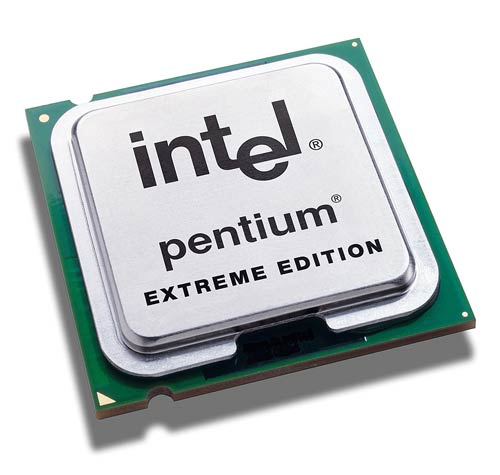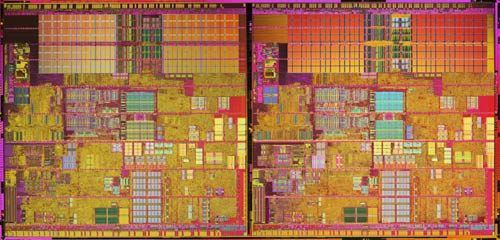Intel Dual Core Performance Preview Part I: First Encounter
by Anand Lal Shimpi on April 4, 2005 2:44 PM EST- Posted in
- CPUs
The Chip: Pentium Extreme Edition
As we mentioned in our IDF coverage, Intel has dropped the number 4 from their naming for their dual core parts. The new dual core desktop CPUs will simply be called the Pentium D and the Pentium Extreme Edition.

Both the Pentium D and Pentium Extreme Edition are nothing more than two 90nm Prescott 1M dies glued together. That means that each core has its own 1MB L2 cache, and that also means that architecturally, these chips are no different than the single core Pentium 4s that are out today - other than the obvious dual core fact.

Contrary to what we've reported earlier, the only difference between the Pentium D and the Pentium Extreme Edition is the presence of Hyper Threading; mainly, the Pentium D doesn't have it, while the Extreme Edition does. Both chips will only use a 800MHz FSB, they both have the same cache sizes, and they only differ in the presence of HT.
Armed with Hyper Threading, the Pentium Extreme Edition allows the execution of 4 concurrent threads and appears as a quad processor CPU to the OS. Without Hyper Threading, the Pentium D only allows for 2 concurrent threads and appears as a dual processor CPU to the OS.
While the Pentium D will be offered in three speed grades, from 2.8GHz up to 3.2GHz, the Extreme Edition will only be launched at 3.2GHz. Note that the fastest single core Pentium 4s run between 3.6GHz and 3.8GHz, so there is a significant clock speed penalty paid by going to dual core.










141 Comments
View All Comments
Icehawk - Thursday, April 7, 2005 - link
The idea is - there are things I'd like to do but currently can't - can these new processors allow it?Ie, Doom3, Azareus, and DVDShrink at once. YES, that IS a realistic test because it is something I'd like to do. Instead I have a second PC eating up electricity to handle downloading & encoding tasks.
Ok, I gotta go read Pt 2!
michael2k - Thursday, April 7, 2005 - link
Did you even read the rest of my post, DaDVD?I quote myself, just in case you didn't see it the first time:
Here's a reason why importing a PST file while opening Photoshop is a valid benchmark:
If you're using, say, Premiere to create a movie, and you want to create a mask, you have Premiere in the background rendering the previews, transitions, and SFX (CPU+HD load) while you open Photoshop, import a frame from the movie, and create your mask.
You then go back to Premiere, apply your mask, and continue editing.
That is also why the DVDShrink test is so important: It's doing a background video encode while the foreground is doing other stuff, which nicely simulates a video workstation load.
Not everyone is a gamer, and not everyone is a casual user. There are some people who make movies, compile code, develop software, and write games, and some of us do read AnandTech.
I'm not ripping hundreds of DVDs, but I have been known to make make about four DVDs a year, and out of those 4 DVDs, I will 'mass produce' each one about 10 times; some of them only get a handful of copies, like 3 or 4, while others get massive numbers of copies, like 20 or 30.
The process of making a DVD is about five hours to get the movie ready and two hours to get the DVD ready, and half an hour per burn.
This is on a 933MHz machine. With a dual, according to the data provided by DVD shrink and importing PST files, that time might go down to two hours to get the movie ready (essentially realtime) and half and hour to get the DVD ready (again realtime), and with the new 8x burners, 10 minutes per DVD.
So if I make 50 DVDs a year, instead of spending 78 hours on it, I can more likely spend 18 hours on it. This on top of the OTHER things I do, like coding and compiling (both of which used to take three hours compiling Mozilla and Firefox on a 400MHz machine, and one hour on a 933MHz machine), or Photoshop, or making photomosaics (a 8000 picture photomosaic takes about 15 hours). Your complaint is like saying, "Reviewing DooM3 at 2048x1600 on the newest NVIDIA card is ludicrous because no one does that!"
phantom505 - Thursday, April 7, 2005 - link
I didn't read every single post here, but the ones I did make me wonder are the ones that are moaning about who beats who to the market.The problem I see is that Intel has no more room to move up in clock speed. AMD does. That means AMD will not be forced into making larger dies as fast as Intel *must*. (where's that 4 GHz chip at?) How the heck is that not a serious advantage?
I'm sure AMD will have to get better multi-tasking going, but compared to what CPU's I still work with are so crude (P3's, older P4's, K7's) I don't see that as being absolutely critical to general system use.
Bottom line is always price, and if Intel has twice the core size, take a guess what the price will be vs AMD's single core.
xsilver - Thursday, April 7, 2005 - link
#111 I find that running multiple ANY programs on an amd64 will screw up the workload; eg browsing and watching dvd; or ripping one disc while watching another; I wouldnt mind if it was something that took 100% cpu cycles so that leaves none for other tasks but browsing and watching dvd at the same time? WTF?#da dvd
I think you are mistaken with the benchmarking that has taken place previously not with what anand is doing now -- benchmarks at many places are done with fresh installs, no sound, tweaked settings, nothing running in background. What anand is doing right now may be a bit extreme; eg. running more things than usual but I don't suppose you do a fresh format everytime you run doom3 either eh? get my point?
PrinceGaz - Wednesday, April 6, 2005 - link
#104 is right. It's not dual-core CPUs or HT that make multi-tasking so much more efficient, it's the efficiency of the Windows Scheduler, or lack of. Personally if I set off stuff I want to run in the background for any length of time, I use Task Manager to reduce its priority to Below Normal so it doesn't slow down anything else I'm working on. I shouldn't have to do that, but there's a difference between foreground application priority, and automatic long-term background low-priority (which Windows does not have). I don't care if it takes five minutes or five hours to finish encoding a movie as it's a background task and I'm in no hurry for the results.Manually lowering the priority of intensive tasks makes a world of difference to responsiveness of seemingly hung apps, such as opening DScaler (a TV deinterlacer/viewer) when some other application is using 100% CPU. I'm surprised Anand didn't just try using Task Manager to lower the priority of whatever was thrashing the CPU so that Outlook could startup quickly.
The advantages of a dual-core processor are very real, every bit as good as dual-core workstations that according to AT no-one has needed until today. I've long been a proponent of dual CPU machines; the mobos don't cost that much more than single CPU versions (though overclocking is rarely, if ever an option on them). The benefits for many people far outweigh the disadvantages of slightly higher cost and slightly lower individual CPU speed. Of course the reduced speed is something you also get with dual-core processors.
It's good to know that all of a sudden to coincide with dual-core CPUs, everyone has just switched from runing single applications in isolation, to running multiple heavy-duty apps at once. It's rather fortunate people weren't multi-tasking like this in the past (ahem) otherwise the lack of dual processor desktop recommendations would have been a major oversight.
Son of a N00b - Wednesday, April 6, 2005 - link
He did not incluse Xeons or Opertunes for obvious reasons...one, this is a DESKTOP cpu not a workstation one, and this article is comparing desktop cpu's, because no dual core workstation cpu's are out...2 because you can simply look at an old review, why make more work?
Da DvD - Wednesday, April 6, 2005 - link
I wanted to add something, how many DVDs to people posess, that ripping them is seen as a common task? Despite my nickname, I only own a few DVDs and sometimes hire one. Do I rip these? No, someone else already did and shared it via P2P. Which means i'll be downloading them, not ripping them.People are talking about price/performance but they forget that they only perform the tasks where DC is twice as fast a few times per month. So the overall performance increase is what, 5%?
So at the moment, unless you're in the bussiness of constantly ripping DVDs while being addicted to games, what use is Dual-Core for the average user?
Da DvD - Wednesday, April 6, 2005 - link
"He wasn't adapting the workload to the product, he was adapting the workload to our requests."Exactly. Doesn't this imply this review will only be helpfull for the few people who made those requests? I won't be ripping DVD's while playing a game. For as simple a reason as that my game disc is in the drive. I won't find myself in the situation where i'm packing files with winRAR while playing a game. Simply because it only takes a few minutes anyway. (Who the hell packs his whole harddrive?) And how often do you import Outlook databases while playing a game? When do you import those things anyway? After reinstalling windows? I certainly dont play games at that stage. So perhaps this allows me to run intensive download programs while gaming? Yes, it does. But my current pc runs Azureus and eMule along with Doom3 just fine, thank you very much.
nweaver - Wednesday, April 6, 2005 - link
You could try using Radview Webload to automate web page surfing for benchmarks. It has page load timers and several other cool features. We use it in house for web site load testing.michael2k - Wednesday, April 6, 2005 - link
#121: If you read Anand's blog, a bunch of us ASKED him to test this way. These tests DO reflect our 'typical' user workloads. He wasn't adapting the workload to the product, he was adapting the workload to our requests.Here's a reason why importing a PST file while opening Photoshop is a valid benchmark:
If you're using, say, Premiere to create a movie, and you want to create a mask, you have Premiere in the background rendering the previews, transitions, and SFX (CPU+HD load) while you open Photoshop, import a frame from the movie, and create your mask.
You then go back to Premiere, apply your mask, and continue editing.
That is also why the DVDShrink test is so important: It's doing a background video encode while the foreground is doing other stuff, which nicely simulates a video workstation load.
Not everyone is a gamer, and not everyone is a casual user. There are some people who make movies, compile code, develop software, and write games, and some of us do read AnandTech.